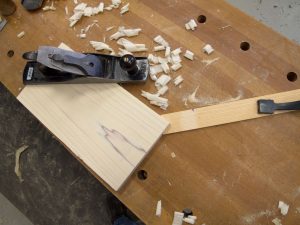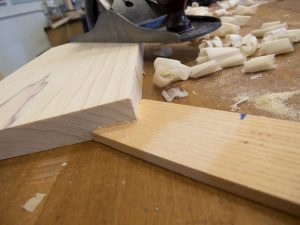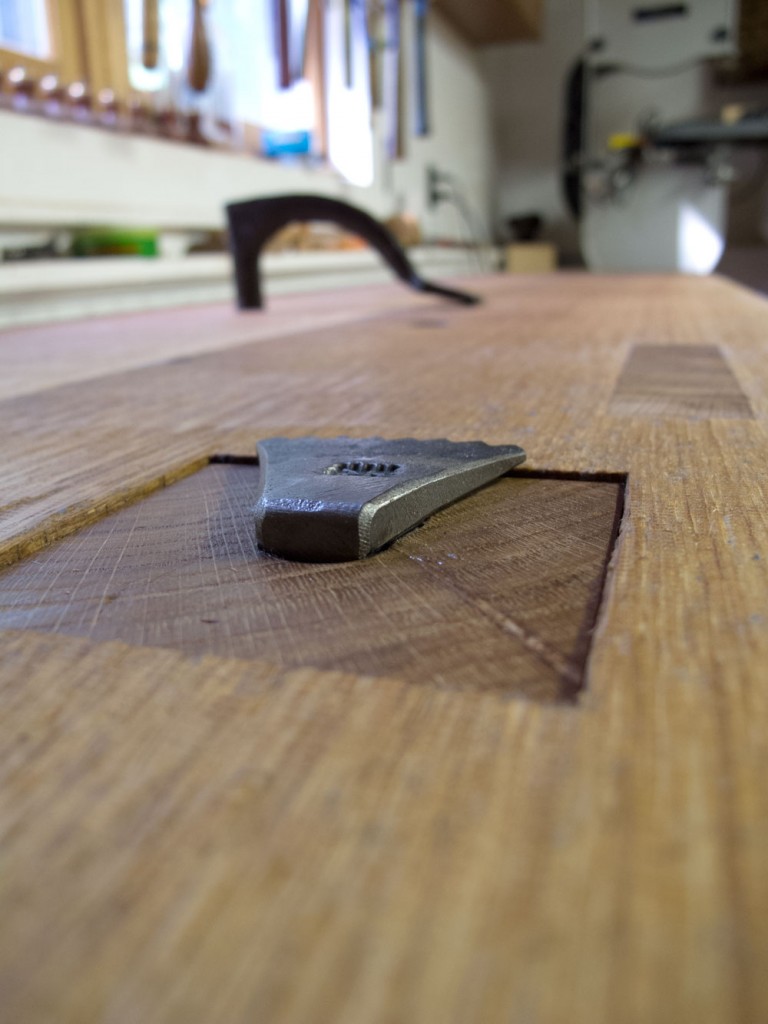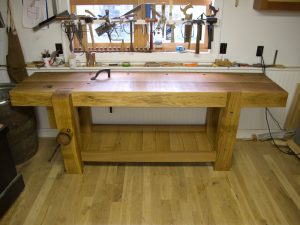We may receive a commission when you use our affiliate links. However, this does not impact our recommendations.
Traversing boards without a tail vise can be tricky. For the last eight years, I’ve used a setup that requires two holdfasts and a batten between them.
It works fine, but it requires a long batten and two holdfasts to work.
Workbench builder Richard Maguire published a tip on his blog this summer that allows you to use one batten, one holdfast and a planing stop for traversing. It’s a great little video – check it out here.
I’ve been using this method on my French oak Roubo bench, which does not have a tail vise or even a strip of dog holes. It has just a metal planing stop and a half-dozen holdfast holes. The notched batten works as advertised. But it is not foolproof.
You have to have a dang-good holdfast that can cinch down hard and not slip. I have a vintage French holdfast on my bench that is heavy, flexible and exerts a death grip on the benchtop.
There are lots of good holdfasts out there, and lots of crap ones as well. Avoid the cast Jorgensens. I have had good luck with the Gramercy, Lie-Nielsen and blacksmith-made holdfasts. If you have a smith make yours, consider using 1”-diameter holes. The extra weight and bearing surface seems to make a difference. Also, ask the smith to make the shaft just a wee shade less than 1” in diameter. My French one is about 7 thou undersized. It makes a difference.
If your holdfast doesn’t hold well, the notched batten will give way when you reach the end of the board next to the planing stop.
You might consider putting some sticky-back sandpaper on the underside of the batten to improve the grip.
Another detail worth mentioning: The notched batten works best if you have a metal planing stop. The harder you push the handplane, the more the metal stop bites into the end grain of your work.
Give it a go. The notch takes two minutes to saw out in scrap and is a definite improvement.
— Christopher Schwarz
I built my first French workbench in 2005 – no tail vise and only a basic leg vise. Since then I’ve built a lot of workbenches with a lot fancier holding devices. This year, I’ve returned to basics with a pure French design. If you’d like to read about French workbenches, I recommend my 2007 book “Workbenches: From Design and Theory to Construction and Use” (Popular Woodworking), which is available at ShopWoodworking.com.
Here are some supplies and tools we find essential in our everyday work around the shop. We may receive a commission from sales referred by our links; however, we have carefully selected these products for their usefulness and quality.













I have used Moxon’s method for more than thirty years. Just plane against the stop: no batten, no holdfast, no fuss. “… turn the Grain athwart the Work-bench and Plane upon the Cross-grain. This way of Cross-grain’d working, is, by Work-men, called Traversing.”
I took your advice Chris and spent the 3 or 4 minutes needed to make one. I just made sure I had it at a 45 degree angle from the edge so it does look like the video more or less. It works like a charm and holds rock solid planing in any direction toward the bench stop and away from the batten.
Thanks for a great tip. I really like simple things that work.
The batten in the video seems to have a 45, but it is not centered on the batten, but offset…looks like a 1:2 ratio, centered on the third of the batten width.
Dawg
Hi Chris,
Another trick from Richard Maguire (i think it’s his first video post) concerning the sloppy holdfasts : he simply dents his holdfast with a nail set.
I haven’t personally tested this method but the video is impressive.
Regards from France (so if i’m not grammatically correct you know why :D)
Greg.
Hi Chris,
Another trick from Richard Maguire (i think it is his first video post) is to dent you holdfast with a nail set.
I haven’t test this solution yet but the video is impressive.
Regards from France (so … if i’m not grammatically perfect, you know why 😀 )
Greg.
Chris
I have another viseless bench helper. Not for planing but it is nifty.. I saw this somewhere.
Make 2 pistol shaped grips of any wood and put a 90 degree notch downa a ways on the top
Jam them against the front of the bench.. It was supposed to be for sawing rod. I made it for sawing round stoch (stick chair parts)..But then I found it is tops for sawing boards to length. You can see the front and the back side cut marks on a board at the same time. I get tired of stopping sawing to lean forward to check the back side cut line. Not a thing of beauty but what a friend. And cheap..
Jennie
Derek Olson (Old Wolf Workshop), in his July 26th blog post, points to Roubo’s plate 14, figure 17 as a possible example of this type of batten. What does the original text say about that illustration?
Hi Chris,
Have you tried rabbets and dados this way? I noticed some wiggle in the video until the batten locks in and was wondering if had encountered any problems. Thanks!
I notice that your batten has a centered v-notch. Richard is very specific in his description (and implementation), showing that it’s a 90 degree notch angled at 45 degrees. I think that might affect the strength that the batten applies to the workpiece, perhaps negating the issue of a weak holdfast.
I’m not sure if this is true, or why it would be. But then again, why would Richard be so specific in his description of the batten? If not for strength, why have the notch angled?
Hi Chris,
Here is an alternative. I have been using this system of planing stops for a number of years now. The planing stops are mounted at right angles to each other and keep the board from rotating when planing diagonally. I have a purpose-built bench for this type of work but of course any bench can be adapted. The planing stops are adjustable in height to a range of 1/2 in. for thicker boards. The length-wise planing stop mounting holes can also be located closer to the end-mounted planing stop.
http://www.normanpirollo.com/PlaningStops.html
Norman
Chris
I use an additional wooden benck stop.
Run a board across the witdth of the bench with blocks underneath each end that snug against the front and rear edges of the bench. Pop it down on the bench against the metal bench hook. Three seconds and and plane away. Have bench
hooks anyways but let them rest.
Jennie